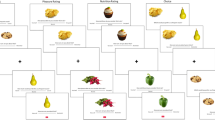Abstract
Building on the notion that consumers are often uncertain about their tastes or weights, this research examines the proposition that consumers might infer their importance weights from their choices and the choice sets they evaluate. It is also hypothesized that the degree to which choice affects self-assessed weights depends on the consumer's familiarity with the product category and the available product information. The results of an experiment demonstrated that consumers' assessments of their importance weights can be influenced by the choice set they previously evaluated. This effect, however, was not moderated by familiarity or provided product information.
Similar content being viewed by others
References
Alba, Joseph W., and J. Wesley Hutchinson. (1987). “Dimensions of Consumer Expertise,” Journal of Consumer Research 14 (March), 411–454.
Alpert, Mark I. (1971). “Identification of Determinant Attributes: A Comparison of Methods,” Journal of Marketing Research 8 (May), 184–191.
Beckwith, Neil E., and Donald R. Lehmann. (1973). “The Importance of Differential Weights in Multiple Attribute Models of Consumer Attitude,” Journal of Marketing Research 10 (May), 141–145.
Brucks, Merrie. (1985). “The Effects of Product Class Knowledge on Information Search Behavior,” Journal of Consumer Research 12 (June), 1–16.
Bem, Darryl. (1972). “Self-Perception Theory.” In L. Berkowitz (ed.) Advances in Experimental Social Psychology. New York: Academic Press, 1–62.
Carpenter, Gregory S., and Kent Nakamoto. (1989). “Consumer Preference Formation and Pioneering Advantage,” Journal of Marketing Research 26 (August), 285–298.
Curry, David J., and Michael B. Menasco. (1983). “On the Separability of Weights and Brand Values: Issues and Empirical Results,” Journal of Consumer Research 10 (June), 83–95.
Huber, Joel, John W. Payne, and Christopher Puto. (1982). “Adding Asymmetrically Dominated Alternatives: Violations of Regularity and the Similarity Hypothesis,” Journal of Consumer Research 9 (June), 90–98.
Mackenzie, Scott B. (1968). “The Role of Attention in Mediating the Effect of Advertising on Attribute Importance,” Journal of Consumer Research 13 (September), 174–195.
March, James G. (1978). “Bounded Rationality, Ambiguity, and the Engineering of Choice,” Bell Journal of Economics 9 (2), 587–608.
Meyer, Robert M., and Thomas C. Eagle. (1982). “Context-Induced Parameter Instability in a Disaggregate-Stochastic Model of Store Choice,” Journal of Marketing Research 19 (February), 62–71.
Nisbett, Richard E., and T. Wilson. (1977). “Telling More than We Can Know,” Psychological Review 84, 231–259.
Park, C. Whan. (1976). “The Effect of Individual and Situational-Related Factors on Consumer Selection of Judgmental Models,” Journal of Marketing Research 13 (May), 144–151.
Ratneshwar, Srinivasan, Allan D. Shocker, and David W. Stewart. (1987) ‘Toward Understanding the Attraction Effect: The Implications of Product Stimulus Meaningfulness and Familiarity,” Journal of Consumer Research 13 (March), 520–533.
Shanteau, James (1980). “The Concept of Weight in Judgment and Decision Making: A Review and Some Unifying Proposals.” Report No. 228, Center for Research on Judgment and Policy, Boulder, CO (July).
Simonson, Itamar. (1989). “Choice Based on Reasons: The Case of Attraction and Compromise Effects,” Journal of Consumer Research 16 (September), 158–174.
Author information
Authors and Affiliations
Rights and permissions
About this article
Cite this article
Simonson, I. The effect of buying decisions on consumers' assessment of their tastes. Market Lett 2, 5–14 (1991). https://doi.org/10.1007/BF00435191
Issue Date:
DOI: https://doi.org/10.1007/BF00435191




